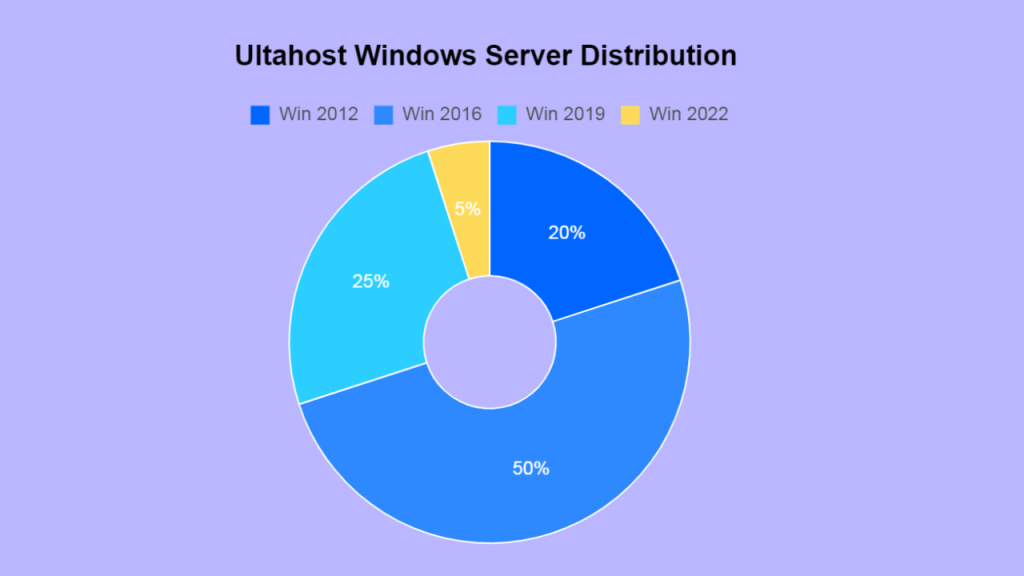Windows Server hosting has come a long way in the last few years. In this article, we will take a look at some of the latest technologies that are available to businesses today. We will also discuss how you can benefit from using Windows Server hosting in your organization. If you’re looking for a cheap and reliable way to host your business applications, Windows Server is definitely the way to go!
The Benefits of Windows Server Hosting
Windows Server hosting provides a number of benefits for businesses, including increased security, scalability, and flexibility.
Security is always a top concern for businesses, and Windows Server hosting provides a number of features that can help keep your data safe. Active Directory integration, for example, allows you to manage user accounts and permissions more securely. Windows Server also offers advanced features like BitLocker encryption and AppLocker application control to help protect your data from unauthorized access.
Scalability is another important consideration for businesses, and Windows Server hosting can provide the flexibility you need to scale your services as your business grows. With support for multiple server roles, you can easily add new servers to your environment as needed without having to reconfigure your entire infrastructure. And with built-in clustering and load-balancing support, you can ensure that your services are always available, even during times of high demand.
Flexibility is another key benefit of Windows Server hosting. With support for a variety of operating systems, including Windows, Linux, and FreeBSD, you can choose the platform that best meets your needs. And with support for virtualization technologies like Hyper-V and VMware, you can easily consolidate your server environment and reduce hardware costs.
Windows Server Usage and Distribution
Windows Server is one of the most popular operating systems for hosting applications. It is used by millions of businesses around the world and its market share continues to grow each year. Since UltaHost is one of the largest providers of Windows Servers plans, Here is a look at some key facts about Windows Server usage and distribution on ultahost servers:

- Over 50% of windows servers are running Windows Server 2016
- Over 5% of enterprise servers are running Windows Server 2022
- Over 25% of windows servers are running Windows Server 2019
- Over 20% of windows servers are running Windows Server 2012
Windows server hosting offers a number of benefits to businesses, including cost savings and increased performance. It is also highly secure, which makes it an attractive choice for businesses that need to protect sensitive data.
Ending Support of Windows Server 2016 in 2023
Microsoft announced in January 2020 that Windows Server 2019, also known as the current Long-Term Servicing Channel (LTSC) version of Windows Server, would be the final LTSC release. This means that after 2023, there will no longer be any support for these versions of Windows Server.
This is a major change for businesses that are used to relying on LTSC versions of Windows Server for years. But Microsoft has also made it easier than ever to transition to the latest version of Windows Server with the Semi-Annual Channel (SAC).
The SAC releases feature more frequent updates and have shorter support lifespans, but they can be a great option for businesses that need to stay up-to-date with the latest technology. And since SAC releases are built on top of LTSC versions, you can expect them to have a more stable and reliable experience than other cloud hosting solutions.
Latest Technologies Available with Windows Server
Windows Server is a group of operating systems designed by Microsoft that supports enterprise-level management, data storage, applications, and communications. It is the successor to Windows Server 2003 and is based on the Windows Vista codebase. The first version of Windows Server was released in 1993.
The latest version of Windows Server, Windows Server 2022, was updated on October 11, 2022. It includes many new features and improvements over previous versions, such as support for containers and Nano Server. Nano Server is a new deployment option that is much smaller and has a lower attack surface than traditional server deployments. Containers allow multiple isolated applications to run on a single server instance, providing better resource utilization and reduced server costs.
Top 10 new Technologies for Windows Server 2022
- Active Directory Integration – This feature allows businesses to securely manage user accounts and permissions, allowing admins to easily set rules, group policies, and set up Active Directory trusts. This is especially beneficial for larger organizations that need more control over their network environment.
- BitLocker Encryption – With the help of BitLocker, admins can easily protect their business data from unauthorized access by encrypting data on the server. This helps prevent unauthorised access and malicious attacks, keeping your confidential information safe.
- AppLocker Application Control – This feature allows admins to control which applications are allowed to run on their servers, ensuring that all programs running on the system are legitimate and safe. This helps maintain the overall security of a server as malicious programs can be blocked.
- Multiple Server Roles for Scalability – Windows Server allows admins to install different roles on their servers, enabling them to assign specific tasks to each role depending on the needs of their business. This allows organizations to tailor their server environments in order to meet their exact needs.
- Clustering & Load-Balancing Support – With the help of this feature, admins can easily create clusters of computers and divide the computing resources between them for better efficiency. This helps balance system performance by evenly distributing tasks across multiple servers, resulting in improved resource utilization and faster response times.
- Support for Windows, Linux & FreeBSD Operating Systems – This feature allows admins to run multiple operating systems on a single server, giving them the flexibility to choose which OS is best suited for their applications. This helps businesses save money by not having to purchase multiple servers with different OS versions.
- Hyper-V Virtualization Platform – This feature enables admins to create multiple virtual machines on a single server, allowing them to maximize the resources of the host machine. With Hyper-V, businesses can easily manage workloads and run applications in isolated, secure environments.
- Storage Spaces Direct for Better Storage Utilization and Scalability – This feature allows businesses to group together multiple hard drives to create a larger pool of storage space, allowing them to quickly and easily access stored data. This helps reduce both cost and complexity when it comes to managing large amounts of data.
- Windows Subsystem for Linux to Run Linux Applications on Windows – This feature allows admins to install a Linux distribution within their Windows Server environment, enabling them to run Linux applications on Windows. This allows businesses to enjoy the benefits of both operating systems, providing greater flexibility for their IT infrastructure.
- Automated Application Deployment & Maintenance – This feature allows admins to define Windows application installation and maintenance tasks, which can then be executed automatically by Windows Server when needed. This helps businesses save time while ensuring that applications are always up-to-date and correctly configured. Automated deployment and maintenance also helps reduce the risk of errors when installing or updating applications, resulting in improved system reliability. To streamline these processes further, businesses can explore oss automation solutions that integrate with their existing infrastructure and tooling.
How Your Business Can Benefit from Windows RDP Connection?
If your business uses Microsoft Windows, then you’re likely familiar with RDP, or Remote Desktop Protocol. This handy tool allows users to connect to a remote Windows computer in order to access files and applications. While RDP has been around for quite some time, many businesses are still not taking advantage of its full potential. Here’s a look at how your business can benefit from using a Windows RDP connection:
RDP provides a fast and convenient way for employees to access work files and applications from any location. With RDP, there’s no need to lug around a laptop or try to remember complex VPN settings. All you need is an internet connection and you can be up and running in no time.
RDP is also a great way to provide customer support. When you enable RDP on your server, customers can connect and give you permission to remotely control their desktops. This allows you to quickly diagnose and fix any issues they may be having.
Another benefit of Windows RDP Servers is that it’s highly secure. All data transmitted between the client and server is encrypted, making it virtually impossible for hackers to eavesdrop on the connection. Plus, since RDP connections are typically initiated by the user, there’s no need to worry about someone gaining unauthorized access to your network.
If your business isn’t already using a Windows RDP connection, now is the time to start. It’s a fast, convenient, and secure way to give employees and customers access to the resources they need.
The Cost-Effectiveness of Windows Server Hosting
It is no secret that Windows Server hosting can be quite expensive. However, many businesses continue to use it because it is a very effective platform. Here, we will discuss the cost-effectiveness of Windows Server hosting in more detail.
As mentioned, Windows Server hosting can be expensive. The main reason for this is because of the licensing fees that are associated with it. In order to use Windows Server, businesses must purchase a license from Microsoft. These licenses can be quite costly, depending on the edition of Windows Server that is being used.
Despite the high cost of licensing, Windows Server remains a popular choice for businesses because it is a very effective platform. It offers a number of features and benefits that make it worth the investment. For example, Windows Server provides businesses with a stable and secure environment for their applications and data. It also offers excellent performance and scalability, making it an ideal choice for businesses that are growing rapidly.
While Windows Server hosting can be quite expensive, it is still a cost-effective solution for many businesses. The features and benefits that it offers make it worth the investment, especially for businesses that are growing rapidly.
The Reliability and Performance of Windows Server
The Windows Server platform is a reliable and high-performance server operating system that enables businesses to deploy critical applications and services. It provides the foundation for a secure, efficient, and scalable server infrastructure, while delivering new levels of performance and security. The Windows Server platform has been designed to meet the needs of today’s businesses by offering a robust, scalable, and secure server environment.
Upcoming Technologies with Windows Server 2022 – 2023
- Automation: Windows Server allows for the automation of many core system and application processes, including deployment, orchestration, management, reporting and more. This helps reduce operational cost as well as improve efficiency.
- Containerization: Windows Server provides support for container-based applications with the ability to run both Windows containers and Linux containers in a single environment. This enables businesses to develop and deploy applications quickly with greater scalability and flexibility across multiple platforms.
- Hyperconverged Infrastructure (HCI): With HCI capabilities built into the platform, organizations can now seamlessly manage their virtualized compute, storage and networking resources from a single console or interface. This reduces complexity while increasing agility by eliminating the need to manage separate components of IT infrastructure separately.
- Artificial Intelligence (AI): AI capabilities are integrated into the platform so that businesses can easily implement machine learning models within their existing workloads without needing specialized hardware or software toolsets outside of what is available on Windows Server 2019 Datacenter edition or higher versions..
- Security: Enhanced security features such as Device Guard help protect against unauthorized code execution at runtime using advanced policy enforcement techniques for improved protection against zero-day attacks; Containers Shield ensures
Conclusion
Windows Server hosting provides many benefits for businesses of all sizes. The latest technologies available with Windows Server can help your business stay competitive in today’s market. Additionally, Windows Server is cost-effective and provides reliable performance. It is also easy to manage and configure, which helps reduce the time and cost associated with IT management.
In terms of reliability, Windows Server has been designed to support the most demanding applications and services. With its advanced fault tolerance features, it can help ensure that your business remains up and running in case of a hardware failure or other disaster. In addition, advanced security features help protect your data and applications from malicious attacks.
Finally, Windows Server offers excellent performance for both physical and virtual environments. It provides a powerful platform with high scalability and availability that is suitable for a wide range of environments. With its built-in tools and technologies, you can easily manage your servers, monitor performance, and optimize your hardware resources.
By choosing UltaHost Cheap Windows VPS Plans, you get unbeatable performance at an affordable price. Deployment only takes 55 seconds. Try UltaHost KVM VPS free for 30 days and experience more benefits!










